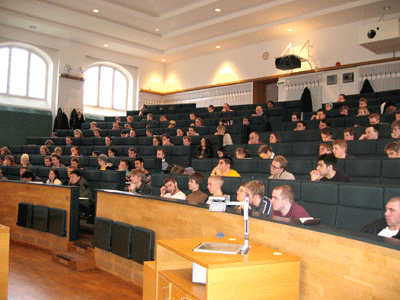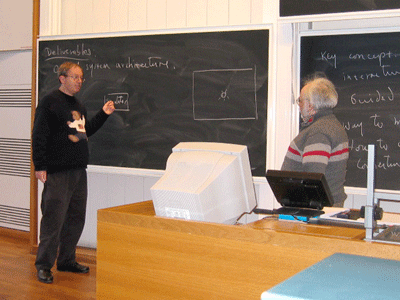Course Description
and Problem Assignment
- Lesson Plan and due dates
- Problem Assignment
- The due date for the assignment is extended to 21 May - Friday. You may send it by KTH internal mail if you can not get access to the department mail box directly.
- Problem Solutions
Project Presentations
Projects are to be presented on 27 May between 10:00-12:00 and 13:00-16:00 in rooms Q11-Q14. You will be given 15 minutes to present your project and can expect questions during your presentation. Any member of a project team may answer questions. You are also expected to be present during the entire hour assigned to your project and thus to listen to at least two other presentations. During the next two weeks your project team will be notified of the time and location for your presentation. You should also bring your written project report with you to the presentation. This should be given to the grader before your turn. Grades will be assigned by a committee consisting of all graders, myself and Rand Waltzman acting as a consultant. Note that if the project is better than the proposal the proposal grade will be increased, thus you can make up for a poor proposal by an excellent project. Also note that you will be expected to understand the physics involved in your project and should be able to answer questions about such matters including questions about the homework assignment.
.
Important Points for the Presentations on May 27th.
1. Rooms are in Quantum
Tom Q11
Fredrik Q12
Linus Q13
Johan Q14
Times are:
X1-X3 10:00
X4-X6 11:00
X7-X9 13:00
X10-X12 14:00
X13-X16 15:00
Where X is T,F,L or J.
Note: your room assignment is given in the returned proposal plan.
2. You should report at the start of your hour and remain for the entire period as audience for the other presentations. Failure to do so may result in grade reduction. The entire group must be present.
3. As part of the Scenerio your potential customer might want to check your mechanics knowledge by asking you about one of the assignment problems. This may or may not happen but you are responsible for understanding the solution to any of the assigned problems!
4. Contact the grader in charge of your presentation in a timely manner so as to insure proper files are transferred to the demonstration machine. If you do not have your own equipment we will provide laptops with recent versions of windows installed.
5. If you are in Tom's group your presentation must be in English. If this is a problem let us know as soon as possible and at least by May 20th. Otherwise you may present your work in English or Swedish.
6. It is up to each group to decide how the presentation will be given, i.e. who will speak. The grader is free however to direct questions to any group member.
7. Grades will not be discussed at the presentation. All graders and myself will meet as a group to discuss each individuals grade from all our available information. You may bring any materials you feel useful to the presentation, for example a copy of the homework assignment, course notes, the text and so forth.


News
The project plans will be returned at the end of class on Wed. 12 May 2004. The room and time assignment for the presentation will be marked on the returned paper.
Please read carefully the section above about the project presentations on May 27th!!
The last three lectures in the course will mainly be about dynamic systems from a semi-popular qualitative point of view.Examples will be drawn from mechanics but we will take a somewhat more general approach and take note of applications in other areas.
More errors in the notes:
With thanks to a careful reading of the Flatland Mechanics notes for finding the following errors:
page 15 - the solution for the max range is not correct and should read
2 tan(theta0)cos(theta0)v0^2/g
page 26 - equation should read
v=x-dot
omega = theta-dot
Homework question 2c
The word "velocity" should be replaced by the word "speed". Also a slight hint, think of the intersection of a moving circle with a fixed circle. This is not the way to do the problem but a good way to see what is going on!
Homework question 4
The inequality should be for t>0 not t<0 as stated. As this is my error I will give full credit for the answer with t<0, however some consideration will be give for the solution with t>0 when arriving at a final grade.
Homework question 5
The form of the Qtheta given just above the statement on page 8 " show the final equations!" is not strictly correct, that is the quantities r1* , r2* and r3* are not what should be there. I leave it to you to find the correct result. My thanks to the two students who pointed this out.
Homework question 6
Some people have asked if the mass can pass through the hole. Assume that it cannot, in fact only solve the problem up to the point that the mass reaches the hole position.
I received the following letter from one of the students in the course:
I have a small
question that you will likely hear many more times in a few weeks when the grades
are about to be calculated. From your website:
"Final Grade = ( planGrade+assignmentGrade+
2* ProjectGrade)/4"
My question: What about if the average for
a person is 4.5? Does he get the final grade 5?
More interesting: if you get
4.25 as average, do you use the "nearest whole number" principle and
hand out a 4 or the "gratious and most liked professor in KTH"
principle and hand out a 5? =)
This was my answer!
Grades
are at best inaccurate in assessing people and two decimal place accuracy is meaningless.
If I had my way it would be pass or fail, but as that is not acceptable here,
we have to live with a subjective system that people use to assess other people!
Therefore when grades fall into boundaries, I will discuss the matter with all
the teachers in the course and look over the materials submitted to arrive at
a final grade. On the day after the presentations, while our memories are fresh,
we will discuss each student's case among ourselves. I certainly will have no
explicit rounding off policy. I'm afraid that is the best answer I can give you.
I hope that this settles the matter.
There has been some inquiries regarding the use of Mathematica for deriving equations of motion. Note that there is a link to programs which I have written for this purpose given below! The subject itself is outside the scope of the present course, however you are free to look at the examples and manual for the SophiaMathematica program and use it in your work if you like.
We are a bit behind in the schedule so the next lecture (7) will cover the conservation of energy and start on the planetary motion problem. Lecture notes for both topics are linked to below.
Errors in notes:
Flatland Mechanics - page 2 in the diagram before the last on the page - should read a<0 and b>0. So far this is the ONLY error I can see!
Projects: A number of students have asked me about what it takes to get a top grade. My answer is that it depends not so much on what you choose but how you implement it. By this I mean that it should have clear and useful goals for the user. It should be interesting to use and inspire interest in the subject. Creativity is always welcome. Note that thhis is for a very good grade. A competent and clear project will get you a good grade. Most important of all, you should understand what you are talking about and the project should show this.
.
Project Material
You are invited to form your own project groups of from 1 to 4 people. If you are having difficulty finding a group send me an email and I will try to connect you with other people in the same situation. M.L.
Java web sites of interest for project development
- A very easy to use ide for developing java programs. It uses uml diagrams in an automatic way.
- On this site you can find java programs for graph plotting and data entry. It is connected with a book on java for scientists but you should be able to extract what you need without the text.
- Link to a KTH physics course on Java. Lots of useful stuff.
- The Java numerics page.
- An example of a physics book on gravity that uses Java.
- Another site with useful code for numerical tasks such as solving differential equations.
Interesting Links
- David Acheson's web site for the course text. Contains problem sheets and computer programs among other goodies. http://www.jesus.ox.ac.uk/~dacheson/mechanics.html
- Are you living in a simulation?
- The Physlet resource
- Videos of physics demonstrations
- For the bold few interested in extensions of complex numbers to higher dimensions.
- A system I developed as a toolkit for Mathematica (SophiaMathematica) for the solution of problems in mechanics. This beta version includes manuals and examples.
- My computer algebra system (Sophia) in a Maple version along with notes by Karl-Erik Thylwe.
- My text on computer algebra and mechanics.
- Julian Barbour has shown that time can be eliminated from Newtonian mechanics. This and other interesting material about the origin of inertia (mass) and the socalled Mach's principle can be found on his web site.
- KANSAS CITY'S HYATT TRAGEDY. Here you can find out more on the situation discussed in the second lecture.
Textbook and Other Reference Material
- From Calculus to Chaos An Introduction to Dynamics by David Acheson, Oxford University Press, 1997. This is the official Course Text
- Nonlinear Dynamics and Chaos by Steven H. Strogatz. Westview. 1994 (available in soft cover) This is an excellent treatment of the subject at a fairly elementary but useful level.
- Celestial Encounters The Origins of Chaos and Stability by Diacu and Holmes, Princeton University Press 1996 (available in soft cover). An easy to read history of the search for a solution to the many body problem of Newtonian mechanics. Swedish scientists played a major role in this story. Lindstedt (name of street we are on) was one of the big players!
- An Imaginary Tale The Story of i by Paul J. Nahin, Princeton University Press. Shows the use of complex arithmetic in solving the Kepler problem.
- Physics for Game Developers by David M. Bourg. O'Reilly 2002. Mainly an advanced mechanics text for those that want to design authentic animations for computer games. Shows how Quaternions, which are a kind of extentsion of complex numbers to 3D space, provide a computationaly efficient tool for mechanics in 3D.
- Game Physics by David H. Eberly, Morgen Kaufmann Publishers. Web Site A very impressive book with lots of advanced topics of interest to game developers and others interested in simulating mechanical reality!
- The Fabric of the Cosmos: Space, Time and the Texture of Reality by Brian Greene. Greene has become a TV superstar with his series on String theory, which has recently been shown on Swedish Television. His newest book is even better and has influenced me in preparing this course. Highly recommended for a great read!
- The book "Structure and Interpretation of Classical Mechanics" by Sussman and Wisdom is available from MIT press and is also free on line with access to the scheme library they use in the text. It is an interesting attempt to use the scheme language to present mechanics in a dynamic way. The material is equivalent to an advanced course in Lagrangian and Hamiltonian mechanics.